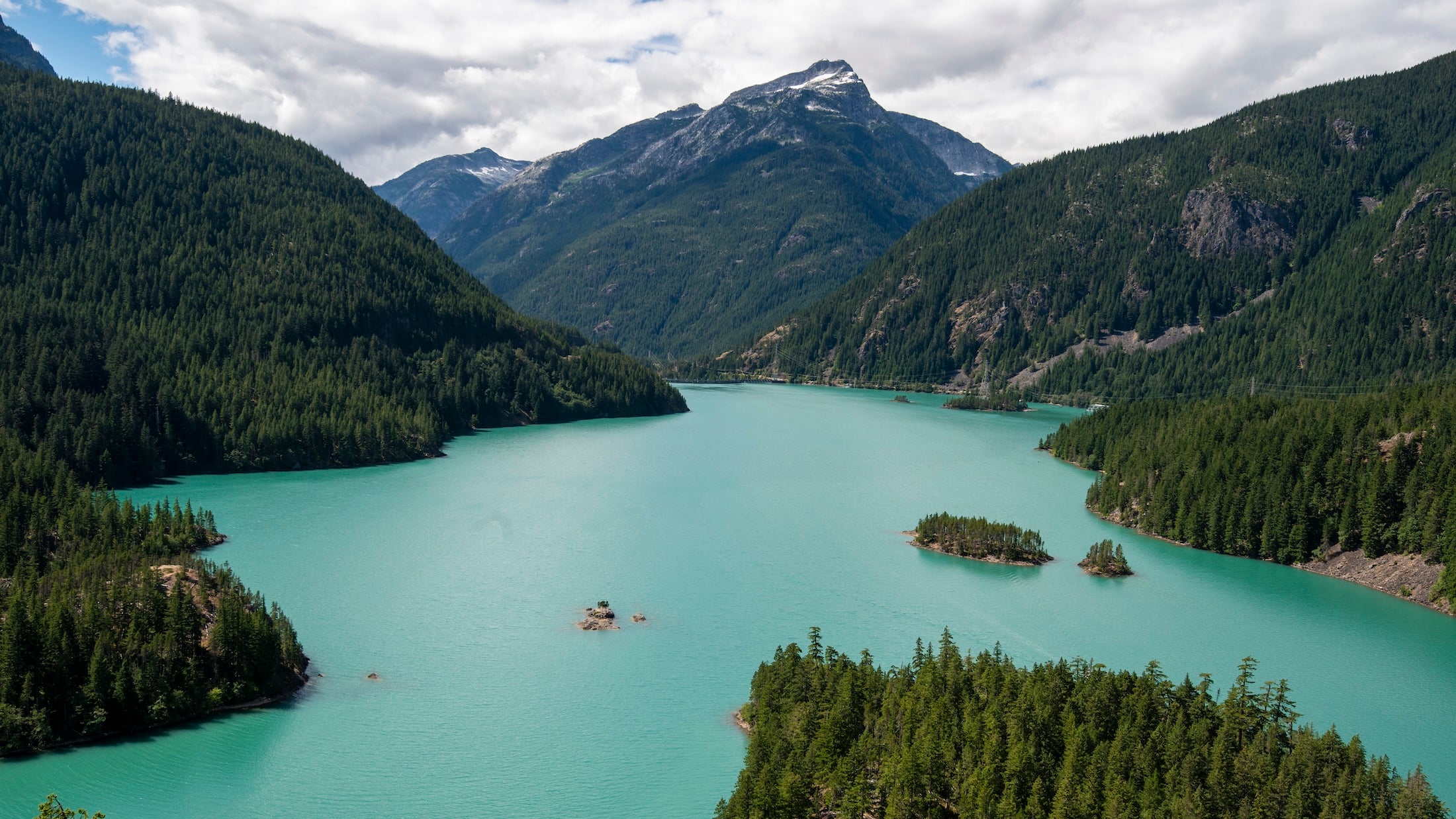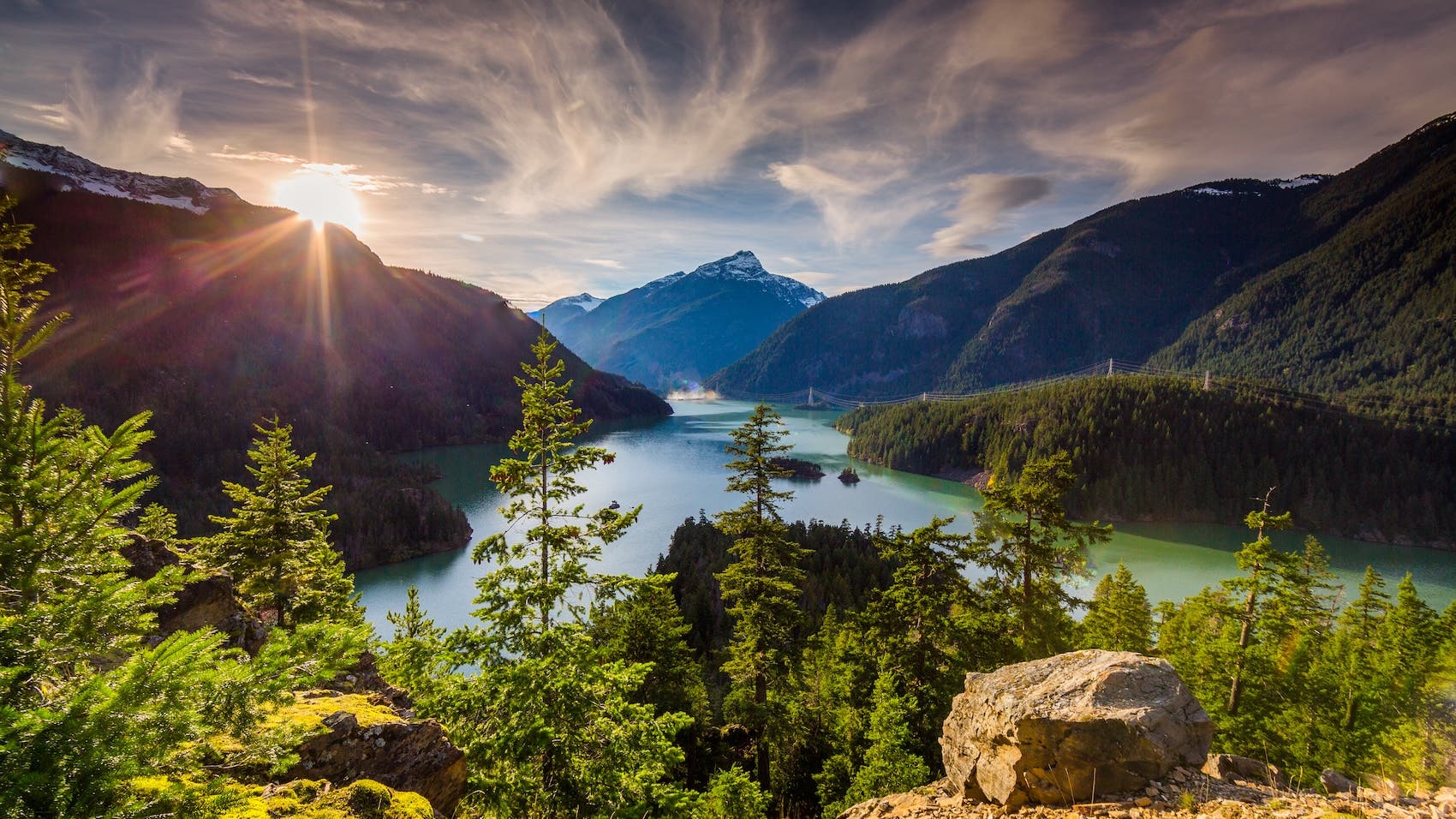Hike to a Jaw-Dropping Turquoise Lake in the 'American Alps'—Without the Crowds or Entrance Fees.

(Photo: Tony Shi Photography via Getty Images)
Feast your eyes on the Diablo Lake Trail. Main course? A lake the color of jeweler’s turquoise. Side Dish? The finest accessible views of the “American Alps.” Where? In North Cascades National Park, the least visited in the Lower 48.
There are multiple routes on the Diablo Lake Trail, and you can’t lose on either one. Each immerses you in old-growth forest, provides views of Diablo Lake either waterside or from vertigo-inducing heights, and spreads out before you, like it’s a movie set. There’s a twice-a-day ferry and a 250-foot-long wood suspension bridge, all with no entry gates, no parking lines, and no entrance fees.
More About The Famous Turquoise Waters
International travel writer Chantelle Kincy ranked the “20 Breathtaking Lakes That Are True Natural Wonders.” No. 19 was Oregon’s Crater Lake. No. 13 was South America’s Lake Titicaca. Crystal-clear Lake Tahoe took the No. 3 spot. What lake topped the charts? No. 1 was Washington state’s Diablo Lake. Kincy gushed: “Vibrant.” “Striking turquoise.”
Brilliant and milky blue-green, Diablo Lake glows as if backlit. The effect is greatest from above, the surface a cloudy, bright aquamarine that reaches a maximum in late summer. That’s when the glacial runoff from the Neve and Colonial glaciers is at its peak. Surveyors claim the lake is only 1.5 square miles, but it feels larger due to a shoreline stretched like taffy along so many tendrils, arms, and bays.
Hikers use single-word exclamations: Awesome! Stunning! Magnificent! Magical! On a sunny late summer day, the lake’s blazing aquamarine does feel like magic. Does your inner child love magic? Keep it that way. But if you prefer to know what’s behind the wizard’s curtain, or why prisms spawn rainbows and butterfly wings fluoresce, then read on.
How To Hike The Diablo Lake Trail
From the second trailhead parking lot, follow the arrow on the “Diablo Lake Trail” sign into a forested portal. In a quarter mile, cross Sourdough Falls Trail, and then a like distance further cross the oft-dry Deer Creek. Rise in an oh-so-civilized climb up the west flank of Sourdough Mountain and picture its famed fire lookout far above. In the 1950s, that lookout and the one on neighboring Desolation Peak, were the summer posts of On the Road’s Jack Kerouac and poet Gary Synder. The next 1.5 miles wind through remnants of old-growth forest, a mix of firs, cedars and hemlocks above, with an understory of ferns and shrub-like vine maple which blazes in fall with vibrant oranges and reds. So far the trail has teased, giving only peek-a-boo glimpses of the sky above and Diablo Lake below.
Reach a powerline clearing and the prelude ends. Take the short spur trail to a Diablo Lake viewpoint. (From this point onward, be alert. The price paid for vistas is steep trailside drop-offs. Keep children and dogs close.) Did you know John Muir loathed the word, “hike?” “I saunter,” he said. Consider channeling Muir and slowing down while the “American Alps” pass in review over the next mile. Try to identify peaks: To the south are Pyramid, Snowfield, and Colonial, to the east Jack, Davis, and Spratt, and northward is Desolation.
Hug the side of the Skagit River gorge and enjoy sheer-drop views as the lake narrows close to Ross Dam. Soon the trail begins to descend, and the second powerline crossing presents a decision. Go on or turn back? The switchbacks ahead quickly drop to the lake’s surface 600 feet below reaching the 250-foot suspension bridge and nearby ferry dock, the classic route’s turnaround point. Turn back at the powerline clearing instead to cut out a knee-testing 600-feet elevation loss and gain.
Four Diablo Lake Trail Options:
Option 1: The classic out-and-back trek. 7.5 miles long and total 1,750 feet of gain.
Option 2: A shorter out-and-back trek that avoids that final 600-foot down and up. Turn around and head back just before that switchback descent at the north end. 6.5 miles long and 800 feet of gain.
Option 3: Hike one-way north and take the ferry back from the Ross Lake Resort dock to the parking lot. 3.7 miles long and 700 feet of gain.
Option 4: Park at the trailhead and take the ferry from the parking lot dock to the Ross Lake Resort dock and then hike over suspension bridge south onto the Diablo Lake Trail back to the parking lot. 3.7 miles long with a 700 feet of gain.
How Do I Take the Ferry at Diablo Lake?
Twice a day, June through September. Departure times: 10 a.m. and 2 p .m. from the Diablo Lake trailhead dock. Return times: 11 a.m. and 2:30 p.m. from the dock at the trail’s end. The trip takes 20 minutes. $10 per person each way, cash or credit card, paid at the ferry.

Basic Facts About Diablo Lake:
Difficulty: Moderate; family and dog friendly (but dogs must be leashed). Keep kids and dogs close where the trail is steep.
Parking: No fee to park at the wayside lots for the Diablo Lake Trail or the Diablo Lake Overlook/Vista across the lake from the trailhead.
Seasonality: State Route 20 closes for the winter, November to April. Latest road conditions: Washington State Dept. of Transportation/Route 20.
Bonus Activities: Diablo Lake has great access for kayaking, paddleboarding, swimming, or sunbathing. Brace yourself. Even at summer’s peak, the water barely creeps over 50 degrees. There is good fishing, even though the lake isn’t stocked. The rainbow trout naturally reproduce, and anglers also report cutthroat, eastern brook, and bull trout. Know your fish: Bull trout are considered threatened and are catch-and-release only. A fishing license is required, so purchase one beforehand.
What’s in a Name: Within view of the trail, Jack Mountain is named for a prospector, and Colonial Peak is named for a nearby mining claim. What’s the provenance of nearby Spratt Mountain? No one seems to have a clue. But I have a theory. It’s as simple as a child’s rhyme. “Jack Spratt could eat no fat, his wife could eat no lean…” A mapmaker with a sense of humor, saw Jack Mountain with an unnamed peak nearby. And the rest was history, in my opinion.
Magic or Science: It’s not magic, it’s flour. Glacial flour. The active Neve and Colonial glaciers grind bedrock into microscopic silica and clay flecks many times smaller than a grain of sand. They’re so light, they remain suspended in the lake’s upper layers. That’s what gives the lake its cloudy, milky appearance. What accounts for the vibrant turquoise, the other half of the equation? Water molecules normally absorb the longer, red wavelengths, and reflect back the short wavelength blues with some green for us to see. In Diablo Lake, the glacial flour absorbs some blue, leaving green dominant, and then reflects back the aquamarine hue as if from a billion tiny jewels.